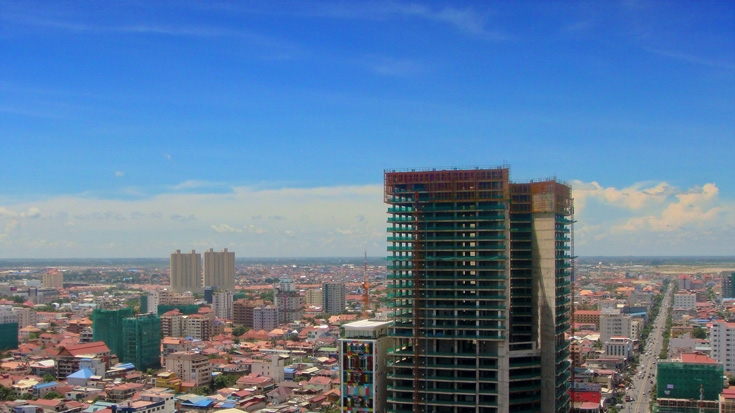Forecast Shows Region to Grow Nearly 7 percent This Year and Next
Cambodia’s Economic Growth remains Strong at 7.2 percent
SINGAPORE, October 6, 2014 – Developing countries in East Asia Pacific will see slightly slower economic growth this year, but the pace of growth in the region, excluding China, will pick up next year, as the gradual recovery in high-income economies boosts demand for exports from the region, according to the East Asia Pacific Economic Update released today by the World Bank. Still, developing East Asia Pacific remains the fastest-growing region in the world.
Developing East Asia will grow by 6.9 percent this year and next, down from 7.2 percent in 2013, the report says. In China, growth will ease slightly to 7.4 percent this year and 7.2 percent in 2015, as the government seeks to put the economy on a more sustainable path with policies addressing financial vulnerabilities and structural constraints. Excluding China, growth in developing countries in the region is expected to bottom out at 4.8 percent this year, before rising to 5.3 percent in 2015, as exports rise and domestic economic reforms advance in the large Southeast Asian economies.
“East Asia Pacific will continue to have the potential to grow at a higher rate – and faster than other developing regions – if policy makers implement an ambitious domestic reform agenda, which includes removing barriers to domestic investment, improving export competitiveness and rationalizing public spending,” said Axel van Trotsenburg, World Bank East Asia and Pacific Regional Vice President.
While the region as a whole will benefit more than any other region from the recovery of the global economy, the impact will vary across countries, depending on their investment and export environment. China, Malaysia, Vietnam and Cambodia are well positioned to increase their exports, reflecting their deepening integration into the global and regional value chains that have driven global trade in the last 20 years.
The report revised the World Bank’s 2014 forecast for Malaysia to 5.7 percent, up from 4.9 percent in April, because of robust exports in the first half of the year. Thailand is also expected to benefit from the global recovery, given its strong integration into global value chains – if the respite in political unrest is sustained.
But in Indonesia, which still relies on exporting commodities, growth will drop to 5.2 percent this year from 5.8 percent in 2013, constrained by falling commodity prices, lower-than-expected government consumption and slower credit expansion.
A bright spot for the region’s economies: robust private consumption, supported by various factors such as election-related spending in Indonesia and a strong labor market in Malaysia. In
the Philippines, buoyant remittances pushed up private consumption, which accounts for more than half of the country’s overall growth, forecasted to be at 6.4 percent this year and 6.7 percent in 2015. Economic growth in Myanmar, with recent institutional and policy reforms and international re-engagement, will be at 8.5 percent this year and next.
Significant uncertainties remain that could affect the region’s growth. High-income economies, especially in the euro zone and Japan, could face downside risks in the near term. Global financial conditions could tighten sharply, and international and regional geopolitical tensions could affect prospects. The region also remains vulnerable to a sharp slowdown in China, which, though unlikely to happen, could hurt commodity producers especially hard, such as metal exporters in Mongolia and coal exporters in Indonesia
“The best way for countries in the region to deal with these risks is to address vulnerabilities caused by past financial and fiscal policies, and complement these measures with structural reforms to enhance export competitiveness,” said Sudhir Shetty, Chief Economist of the World Bank’s East Asia and Pacific Region.
The report identifies policy recommendations for different countries to deal with risk and embark on a path of sustainable growth. Mongolia and Lao PDR, for example, need to reduce the fiscal deficit and tighten monetary policy. In Indonesia, Malaysia, the Philippines, and Thailand, measures to bolster revenues and reduce poorly targeted subsidies will help create space for productivity-enhancing investments and poverty-reducing spending, while gradually rebuilding fiscal buffers.
In China, as the government seeks to strike a balance between containing growing risks and meeting growth targets, the report indicates that structural reforms in sectors previously reserved for state enterprises and services could help offset the impact of measures to contain local government debt and curb shadow banking.
The report also discusses long-term structural reforms that will help countries maximize the benefits from the global recovery. Key reforms include investing more in infrastructure, improving trade logistics, and liberalizing services and foreign direct investment. And, as many education systems in the region aren’t producing skills demanded in the labor market, the report recommends a comprehensive strategy to address issues ranging from early childhood development to higher education and lifelong learning.

